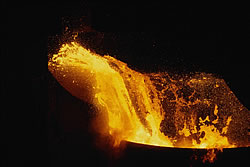Processed halogen free fuel - cycled not stirred
This integrated process for electrical generation has been built for thermoplastics/polymeric materials with low/high content of inert materials, metals and halogens. Waste material and products that may provide potential source material for this process include; electronic scrap, shredder light fraction and the heavy fraction resulting from plastic waste and domestic refuse. An example source product could be the housing fractions of computer towers, which contain chlorine and bromine. At about 400 degrees Celsius the procedure uses nitrogen to strip and decompose the halogenated compounds, and does so without forming significant amounts of chlorinated biphenyls, dioxins and furans. This process takes place in a gas tight rotary kiln whereby the conveyer screws and spheres mix the material, such that the spheres literally grind the residue material. For the cycled spheres reactor, an inner circle of spheres working in conjunction with the reactor's residence time behaviour and optimal heat transfer of other spheres, creates small distributions of molecular weight in relation to possible time. Then, depending on the desired molecular weight, products are derived during the liquid or gaseous state. A contaminated environment is also avoided due to the defined immobilisation of the halogens, which in turn eliminates external environmental emissions of halogenated compounds like dioxins and furans. When compared to stirred reactors, this cycled reactor has shorter reaction times, displays higher quality control and has less feed loss, due to the reduced production of gaseous side products. Further benefits are also realised when the reactor units are coupled together, which enables the extraction of different oil fractions for fuel substitutions or for phenolic glue. Post treatment procedures also decompose any residue dioxins and furans thus decomposing all contaminants.

